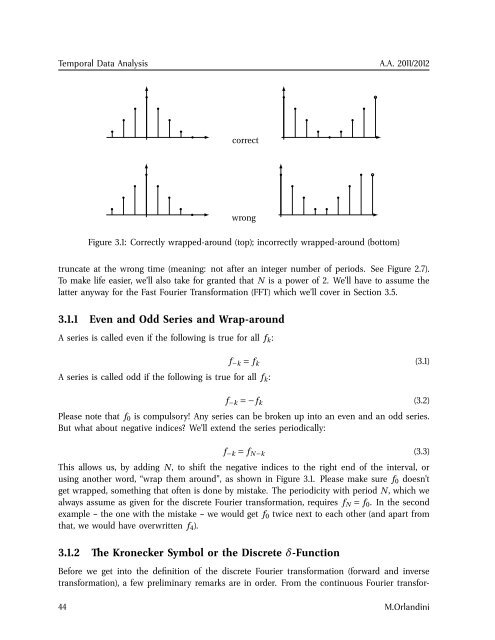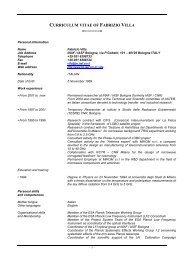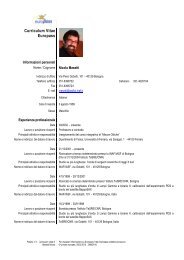booklet format - inaf iasf bologna
booklet format - inaf iasf bologna
booklet format - inaf iasf bologna
You also want an ePaper? Increase the reach of your titles
YUMPU automatically turns print PDFs into web optimized ePapers that Google loves.
Temporal Data Analysis A.A. 2011/2012<br />
correct<br />
wrong<br />
Figure 3.1: Correctly wrapped-around (top); incorrectly wrapped-around (bottom)<br />
truncate at the wrong time (meaning: not after an integer number of periods. See Figure 2.7).<br />
To make life easier, we’ll also take for granted that N is a power of 2. We’ll have to assume the<br />
latter anyway for the Fast Fourier Trans<strong>format</strong>ion (FFT) which we’ll cover in Section 3.5.<br />
3.1.1 Even and Odd Series and Wrap-around<br />
A series is called even if the following is true for all f k :<br />
A series is called odd if the following is true for all f k :<br />
f −k = f k (3.1)<br />
f −k = −f k (3.2)<br />
Please note that f 0 is compulsory! Any series can be broken up into an even and an odd series.<br />
But what about negative indices? We’ll extend the series periodically:<br />
f −k = f N−k (3.3)<br />
This allows us, by adding N, to shift the negative indices to the right end of the interval, or<br />
using another word, “wrap them around”, as shown in Figure 3.1. Please make sure f 0 doesn’t<br />
get wrapped, something that often is done by mistake. The periodicity with period N, which we<br />
always assume as given for the discrete Fourier trans<strong>format</strong>ion, requires f N = f 0 . In the second<br />
example – the one with the mistake – we would get f 0 twice next to each other (and apart from<br />
that, we would have overwritten f 4 ).<br />
3.1.2 The Kronecker Symbol or the Discrete δ-Function<br />
Before we get into the definition of the discrete Fourier trans<strong>format</strong>ion (forward and inverse<br />
trans<strong>format</strong>ion), a few preliminary remarks are in order. From the continuous Fourier transfor-<br />
44 M.Orlandini

















